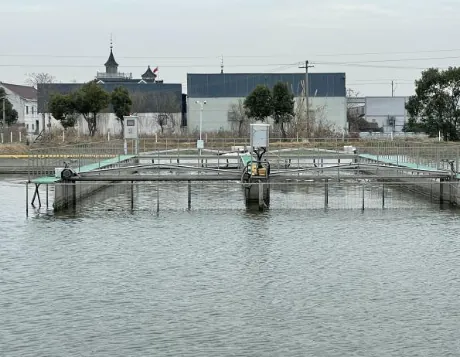
Smart Aquaculture Solution
AquaIntel Pro: End-to-End Precision Farming Platform
for Sustainable Aquaculture
Our IoT aquaculture technology uses technologies such as IoT, big data and artificial intelligence to help customers discover and deal with problems in a timely manner through the real-time monitoring and early warning system of the cloud platform, reduce disease losses, reduce labor costs and resource waste, and achieve precise and automated management of the breeding process.
IoT Aquaculture Solution Applications
High-Value Fish
Real-time biometric monitoring:
IoT sensors track fish behaviorand physiological stress indicators via underwater cameras/AI analytics, enabling early disease detection and optimized feeding schedules.
Automated environmental control:
Integrated sensors (O₂, pH, temperature) trigger automated adjustments in aeration, water exchange, or cooling systems when thresholds are breached, reducing mortality risks.
Critical Hatchery Control
The project is equipped with six major systems, including a circulating water purification and treatment system, a fish fry entry and exit system, a constant temperature system, an automatic supplementary lighting system, an automatic feeding system, and an energy management system.
Through the Internet of Things perception and centralized software control, it achieves 7x24-hour fully automatic operation, realizing sterile and constant temperature breeding regardless of the season.
RAS Contaminant Control
Closed-loop water management: IoT systems automate filtration, UV sterilization, and bio-remediation (e.g., using probiotic-infused water) based on real-time toxin/ammonia readings. Nanomaterials like Ag-NPs or CNTs are deployed to adsorb heavy metals when sensors detect pollution spikes
Disease Prevention
pH anomaly detection + pathogen; database Reduce disease-related losses by 67%
Why You Choose Our Bolts
Hyper-Efficiency & Cost Slashing / Automation-First Design Minimizes Labor & Resource Waste
Risk Elimination Ecosystem / Predictive Threat Management Before Losses Occur

Recirculating Aquaculture System (RAS)
Hyper-Efficiency & Cost Slashing
Automation-First Design Minimizes Labor & Resource Waste
AI-Powered Feed/Oxygen Optimization:
Reduce feed waste by 18-35% via real-time ORP (Oxidation-Reduction Potential) monitoring
Energy-Smart Aeration:
Nano-bubble systems cut energy use by 40% while maintaining DO ≥5mg/L
Labor Reduction:
24/7 automation replaces 70% manual operations (feeding, water exchange)
Smart Aquaculture Solution
Risk Elimination Ecosystem
Predictive Threat Management Before Losses Occur
Disease Outbreak Alerts:
Detect pH fluctuations (±0.5/hr) correlating to 92% pathogen outbreaks
Cascade Failure Prevention:
Integrated DO/Ammonia sensors trigger backups when NH₃-N >0.2mg/L
Stock Loss Shield:
Underwater robots identify abnormal fish behavior 72hrs before mortality

Bolts
Briefly introduce this digital aquaculture system
Based on standard aquaculture ponds or modern aquaculture factories, water quality monitoring systems, hardware automatic control systems, video surveillance systems, meteorological condition monitoring systems, mobile phone remote operation systems, etc. are constructed to achieve real-time monitoring and regulation control of the aquaculture water quality environment. Facilities and equipment such as automatic control oxygen pumps; Equipped with software functions such as agricultural operation management, input management, biological growth monitoring, statistics and analysis, etc., to achieve full digital coverage throughout the entire park.
Can legacy ponds integrate without full retrofit?
Yes – Our modular system supports:
Phase 1: Deploy sensors + gateway ($12k)
Phase 2: Add automation controls ($18k)
Phase 3: Blockchain/robotics ($22k)
How fast is ROI for a 10-acre fish farm?
12-18 months typically:
Labor savings: $48k/yr
Feed reduction: $35k/yr
Mortality drop: $62k avoided loss
$140k hardware cost covered in Year 1.
How reliable are disease predictions?
89% accuracy via machine learning:
Trained on 700+ outbreak events
Cross-references pH shifts, gill movement, and feeding response
Sends Tier-3 alerts (72hr pre-symptom window)
Related Blogs
-
![Smart IoT Radar Level Sensor Smart IoT Radar Level Sensor]() Smart IoT Radar Level Sensor – Professional Q&AQ1: What is the core measuring technology of this radar level sensor? How does it compare with ultrasonic sensors?A1: Our device uses FMCW (Frequency Modulated Continuous Wave) millimeter-wave radar technology. Unlike ultrasonic sensors, it is completel
Smart IoT Radar Level Sensor – Professional Q&AQ1: What is the core measuring technology of this radar level sensor? How does it compare with ultrasonic sensors?A1: Our device uses FMCW (Frequency Modulated Continuous Wave) millimeter-wave radar technology. Unlike ultrasonic sensors, it is completel -
![The definition of online water quality monitoring sensors The definition of online water quality monitoring sensors]() The definition of water quality sensorsA water quality sensor is an analytical device capable of detecting one or more specific physical or chemical properties in water bodies and converting the concentration or intensity of these properties into electrical signals that can be recorded, displayed an
The definition of water quality sensorsA water quality sensor is an analytical device capable of detecting one or more specific physical or chemical properties in water bodies and converting the concentration or intensity of these properties into electrical signals that can be recorded, displayed an -
![The Smart Greenhouse Automated Monitoring And Control System The Smart Greenhouse Automated Monitoring And Control System]() The Smart Greenhouse Revolution: How an Automated Monitoring and Control System Is Revolutionizing AgricultureFarming has long been an act of cooperation between man and nature, depending on intuition, experience, and chance for its success. Now, however, with climate change and global population ex
The Smart Greenhouse Revolution: How an Automated Monitoring and Control System Is Revolutionizing AgricultureFarming has long been an act of cooperation between man and nature, depending on intuition, experience, and chance for its success. Now, however, with climate change and global population ex
Related Videos
Related Videos
Briefly introduce what is aquaculture
Related Videos
Briefly introduce this digital aquaculture system
CUSTOMER SERVICE
Contact Us
Thank you very much for your interest in us! If you want to contact us, you can contact us through the following methods:
Mob
+86-13520127780
Add:
Wanrun Building, Building 7, Yard 1, Haiying Road, Fengtai District, Beijing, 100070,China


















